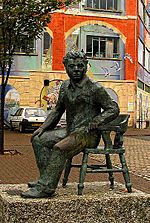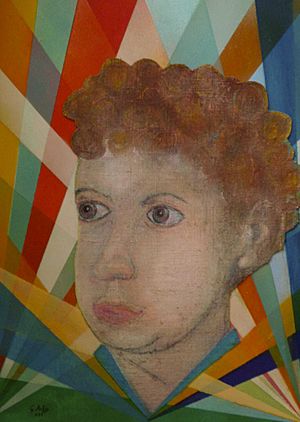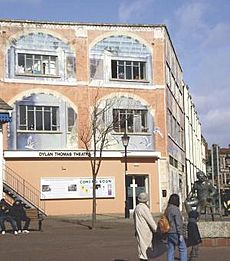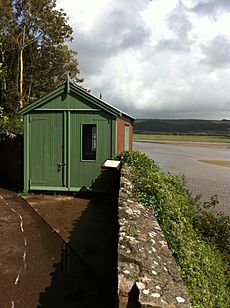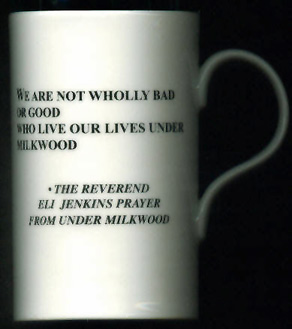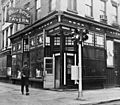Dylan Thomas facts for kids
Quick facts for kids
Dylan Thomas
|
|
|---|---|
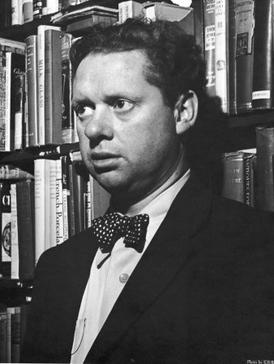
Thomas at the Gotham Book Mart,
in New York City, 1952 |
|
| Born | Dylan Marlais Thomas 27 October 1914 Swansea, Wales, United Kingdom |
| Died | 9 November 1953 (aged 39) Greenwich Village, New York City, United States |
| Resting place | Laugharne, Carmarthenshire, Wales |
| Occupation | Poet and writer |
| Literary movement | Modernism |
| Spouse |
Caitlin Macnamara
(m. 1937) |
| Children | Llewelyn Edouard Thomas (1939–2000) Aeronwy Bryn Thomas (1943–2009) Colm Garan Hart Thomas (1949–2012) |
Dylan Marlais Thomas (27 October 1914 – 9 November 1953) was a famous Welsh poet. He was born in the town of Swansea, Wales. He published his first book of poetry in 1932. Besides writing poems, he was also a wonderful speaker. He traveled around the United Kingdom and the United States reciting his poems. He wrote special works for radio, including "A Child's Christmas in Wales" and "Under Milk Wood".
Dylan Thomas is one of the famous people shown on the cover of The Beatles' album, Sgt. Pepper's Lonely Hearts Club Band.
Contents
Life and Work of Dylan Thomas
Early Life and Education
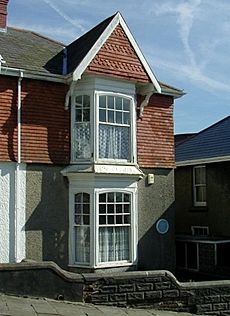
Dylan Thomas was born on 27 October 1914 in Swansea. His mother was Florence Hannah, a seamstress, and his father was David John Thomas, a teacher. His father taught English literature at a local grammar school. Dylan had one older sister, Nancy Marles. Even though his parents spoke both English and Welsh, Dylan and his sister only spoke English.
Dylan had health problems like bronchitis and asthma from childhood, which he dealt with his whole life. He first went to a private school called Mrs Hole's dame school.
In October 1925, Dylan started at Swansea Grammar School for boys, where his father taught. He loved to read. In his first year, one of his poems was printed in the school's magazine. Before he left, he became the magazine's editor. During his last years at school, he began writing poems in notebooks. In 1931, when he was 16, Dylan left school. He became a reporter for the South Wales Daily Post, but he left after 18 months.
Dylan continued to work as a freelance journalist for several years. During this time, he kept writing in his notebooks. Between 1930 and 1934, he wrote about 200 poems. Half of the 90 poems he later published were written during these years.
Becoming a Published Poet (1933–1939)
Dylan Thomas was still a teenager when many of his most famous poems were published. These included "And death shall have no dominion", "Before I Knocked", and "The Force That Through the Green Fuse Drives the Flower". "And death shall have no dominion" appeared in the New English Weekly in May 1933.
When "Light breaks where no sun shines" was published in The Listener in 1934, it got the attention of important literary figures in London. They contacted Dylan, and his first book of poems, 18 Poems, was published in December 1934. The book was praised by critics and won a contest. This brought him new fans, including famous poets like Edith Sitwell.
In September 1935, Dylan met Vernon Watkins, and they became lifelong friends. In 1936, his next collection, Twenty-five Poems, also received great reviews. He wrote half of his poems while living at his childhood home in Cwmdonkin Drive before moving to London.
In early 1936, Dylan met Caitlin Macnamara, a dancer. They met in a pub in London. They married in Penzance, Cornwall, on 11 July 1937. In early 1938, they moved to Wales and rented a cottage in the village of Laugharne. Their first child, Llewelyn Edouard, was born on 30 January 1939.
Life During Wartime (1939–1945)
Due to financial difficulties, Dylan and his family left Laugharne in July 1940. They moved to the home of a critic named John Davenport. There, Dylan worked with Davenport on a story called The Death of the King's Canary.
At the start of the Second World War, Dylan was concerned about being called up for military service. He was classified as Grade III due to his health, meaning he would be among the last to be called. Dylan earned money by writing scripts for the BBC. This gave him a regular income and showed he was doing important work during the war.
In February 1941, Swansea was bombed by German planes. Many streets, including Castle Street and the Kardomah Café, were destroyed. Dylan walked through the damaged town with a friend and felt very sad, saying, "Our Swansea is dead." After the bombing, he wrote a radio play called Return Journey Home, which described the café as being "razed to the snow."
In May 1941, Dylan and Caitlin moved to London. Dylan hoped to find work in the film industry. He found a job with Strand Films, which gave him his first steady income since his newspaper job. Strand Films made movies for the government. Dylan wrote scripts for at least five films in 1942, including This Is Colour and New Towns For Old. He also wrote These Are The Men (1943) and Conquest of a Germ (1944).
In March 1943, Caitlin gave birth to their daughter, Aeronwy, in London. They lived in a small studio apartment.
In 1944, because of the threat of German bombs in London, Dylan moved his family to a cottage near Llangain. There, he started writing poetry again, completing "Holy Spring" and "Vision and Prayer". In September, Dylan and Caitlin moved to New Quay, which inspired his radio piece Quite Early One Morning. This piece was a first idea for his later famous work, Under Milk Wood. One important poem written at this time was "Fern Hill".
Broadcasting Years (1945–1949)
While Dylan had written for the BBC before, it was not a main source of income. In 1943, he wrote and recorded a talk called "Reminiscences of Childhood" for BBC Wales. In December 1944, he recorded Quite Early One Morning. On 31 August 1945, the BBC Home Service broadcast Quite Early One Morning. In the three years after October 1945, Dylan made over a hundred broadcasts for the BBC. He was hired not just for reading his poems, but also for discussions and reviews.
By late September 1945, the Thomas family had left Wales and were staying with friends in London. The publication of Deaths and Entrances in 1946 was a big moment for Dylan. A poet and critic named Walter J. Turner said, "This book alone, in my opinion, ranks him as a major poet."
In the second half of 1945, Dylan began reading for the BBC Radio show, Book of Verse. This gave him a regular income. Dylan remained a popular guest on BBC radio talk shows.
In May 1949, Dylan and his family moved to their final home, the Boat House at Laugharne. This house was bought for him by Margaret Taylor. Dylan also got a small garage near the house, which he turned into his writing shed. He wrote several of his most famous poems there. Before moving into the Boat House, Dylan rented "Pelican House" for his parents, who lived there from 1949 until 1953. His father passed away there.
Caitlin gave birth to their third child, a boy named Colm Garan Hart, on 25 July 1949.
Later Life and Passing
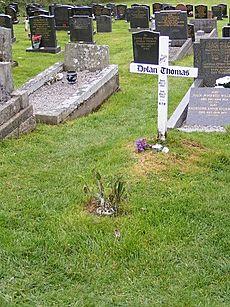
Dylan Thomas arrived in New York on 20 October 1953 for another tour of poetry readings and talks. He had been feeling unwell before his trip.
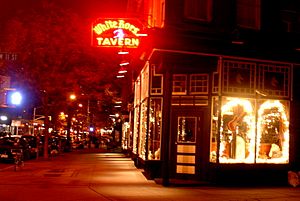
In the early morning of 5 November, Dylan's breathing became very difficult. An ambulance was called, and he was taken to St Vincent's Hospital.
Dylan Thomas passed away at noon on 9 November.
After His Death

After his death, Dylan Thomas's body was brought back to Wales. He was buried in the village churchyard at Laugharne. His funeral took place at St Martin's Church in Laugharne on 24 November. Six friends from the village carried his coffin. His wife, Caitlin, walked behind the coffin with his childhood friend Daniel Jones. The procession was filmed.
His wife, Caitlin, passed away in 1994 and was buried next to him. Dylan's father died in 1952, and his mother in 1958. His elder son, Llewelyn, died in 2000, his daughter, Aeronwy, in 2009, and his youngest son, Colm, in 2012.
Dylan Thomas's Poetic Style
Dylan Thomas is seen as part of the modernism and romanticism movements in poetry.
His writing style often used strong words and images, even when following strict poem forms, like in his famous poem "Do not go gentle into that good night". He carefully arranged his images in a pattern. A main idea in his work was the connection of all life, the ongoing process of life, death, and new life that links different generations.
Dylan Thomas believed that biology was like a magical change that brought different things together into one. In his poetry, he tried to create a special way to celebrate this unity.
He saw people as being part of cycles of growing, loving, having children, new growth, dying, and new life. Dylan got his ideas and images from the Bible, Welsh folklore, and old stories.
Dylan once shared that the poems that influenced him the most were Mother Goose rhymes. His parents taught them to him when he was a child:
I should say I wanted to write poetry in the beginning because I had fallen in love with words. The first poems I knew were nursery rhymes and before I could read them for myself I had come to love the words of them. The words alone. What the words stood for was of a very secondary importance ... I fell in love, that is the only expression I can think of, at once, and am still at the mercy of words, though sometimes now, knowing a little of their behaviour very well, I think I can influence them slightly and have even learned to beat them now and then, which they appear to enjoy. I tumbled for words at once. And, when I began to read the nursery rhymes for myself, and, later, to read other verses and ballads, I knew that I had discovered the most important things, to me, that could be ever.
Dylan Thomas was also a skilled writer of prose poetry, which is like poetry written in paragraphs. His collections like Portrait of the Artist as a Young Dog (1940) and Quite Early One Morning (1954) show he could write touching short stories. His first published prose work was After the Fair, printed in The New English Weekly on 15 March 1934. Dylan's fiction writing can be divided into two main types: lively, imaginative stories with a poetic feel, and, after 1939, more straightforward stories.
Images for kids
-
The Boat House, Laugharne, the Thomas family home from 1949
-
Plaque in memory of Thomas, in Poets' Corner, Westminster Abbey
See also
 In Spanish: Dylan Thomas para niños
In Spanish: Dylan Thomas para niños


